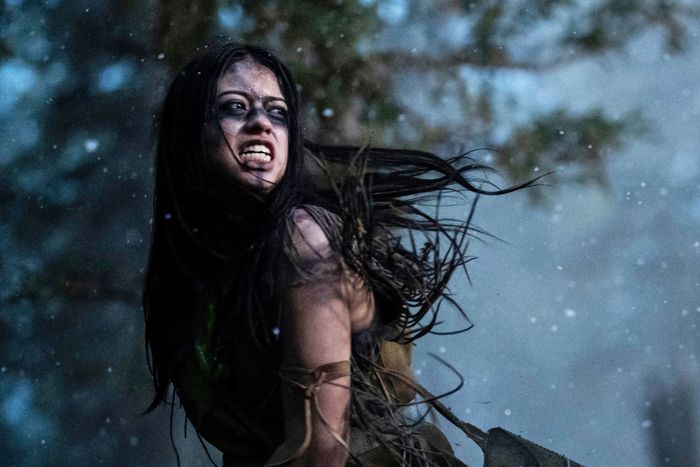
The first Predator came out in 1987 at the peak of the muscle-movie era, and its ensemble exuded levels of testosterone that can only really be obtained with some anabolic assistance. Former wrestler and Minnesota governor Jesse Ventura slung around the kind of rotary machine gun usually mounted to a helicopter. Carl Weathers engaged in a friendly hand clasp that turned into an impromptu arm wrestle that lives on in memes. And Arnold Schwarzenegger, the burliest of them all, played a smirking sentient pectoral muscle with the undeniably badass nickname of “Dutch.” The Predator, a member of an extraterrestrial race devoted to trophy hunting across the galaxy with plasma cannons and cloaking capabilities, felt less like an invention unto itself than a response to all this Reaganite he-manning. No human could possibly challenge Dutch and his team of hypermacho paramilitary contractors, so why not pit them against an opponent who’s not of this Earth? There was an exhilarating lack of exposition accompanying the Predator in that first movie, in which the face-off was the point. When Dutch asked the dying alien what it was, it just laughed in his face and blew itself up.
As admirable as that fuck you to backstory was, success demanded more, and as sequels took the species from (then) near-future Los Angeles to an Antarctic island to an intergalactic game preserve and beyond, all the material gradually began weighing down a simple premise — what if “The Most Dangerous Game” with aliens? — with more and more mythology. The Predators got a name and warring tribes and dogs, and the best part of the new movie, Prey, is that none of these things actually matter. Prey, the fifth movie in the Predators series, takes place in 1719 in the Northern Great Plains, and it shucks off all that lore like unnecessary armor to return itself to a lean story of messily aligned humans facing down an advanced alien enemy. The film itself is just fine, a nimbly directed but clunkily scripted action movie that follows a young Comanche woman named Naru (Legion’s Amber Midthunder) who aspires to defy the gendered roles in her community and become a hunter. But the concept is liberating; director Dan Trachtenberg and writer Patrick Aison understood that a franchise needn’t keep sprawling out with explanatory details — they could take its basic elements and build in another dimension.
Studio movies are so deeply beholden to the familiar at this point that it can seem like we’re trapped in a world of finite ideas that can be continued or remade but never actually replaced with something new. Prey comes as close to fresh material as feels possible within the boundaries of its fictional universe. It takes the idea that Predators have been visiting Earth to hunt throughout human existence and follows it a few centuries back to a North America that’s in the process of being colonized but still primarily in the hands of its indigenous inhabitants. In grounding its story in the experiences of an 18th-century tribe member, the film doesn’t just make a Native woman its protagonist, it presents a scenario, rich with potential, in which a high-tech adversary has to be taken down with arrows, tomahawks, a primitive pistol provided by a French trapper, and bloody determination — well, all those things and a dashing (terrestrial) dog who’s kind of a scene-stealer.
Trachtenberg made his directorial debut with 10 Cloverfield Lane, a sideways successor to the 2008 found-footage monster movie Cloverfield that was more anthology entry than sequel. There’s one pointed nod back to an earlier film in Prey, but it, too, otherwise largely exists on its own terms. Those terms aren’t always ideal — Midthunder may be a capable action lead, but much of the dialogue surrounding her struggle to join her brother Taabe (Dakota Beavers) as a hunter sounds like it could have been repurposed from a TV movie about a girl wanting to join her high-school football team. Still, Trachtenberg finds plenty of opportunities for pulpy beauty, like the scene in which Naru and another hunter hide in the long grass at magic hour after a carnage-heavy run-in with the Predator. It’s all extremely Malick lite, right up until the lights from the alien’s targeting lasers appear on one of their foreheads.
These characters aren’t party to the sequels, crossovers, novelizations, and comics that have made this particular strain of intellectual property so enduring and unwieldy. Rather than expand on what’s already established, Prey limits itself to the perspective of a group of people who find their safety and way of life infringed on by two separate groups of destructive invaders — one from across the Atlantic and the other from outer space. In some ways, it’s a return to form that evokes and, less effectively, rebukes the brawny original. But it’s also refreshing to go back in order to move things forward. Hell, why not go further? There are thousands of years of human history to sic an extraterrestrial hunter on.


